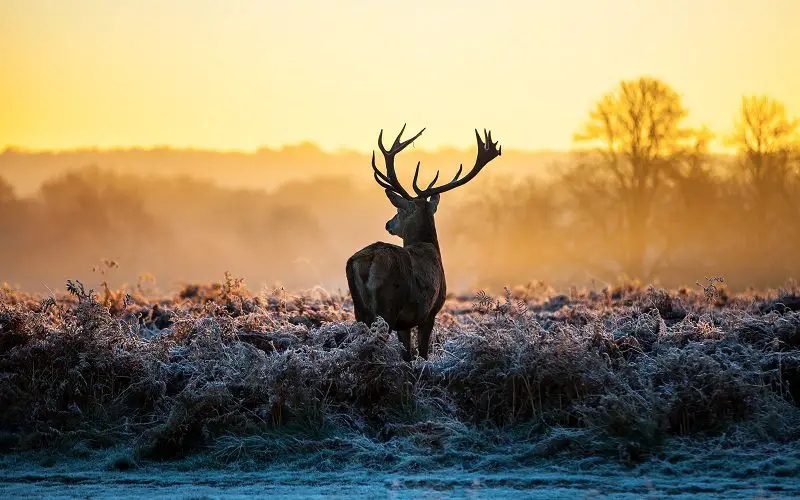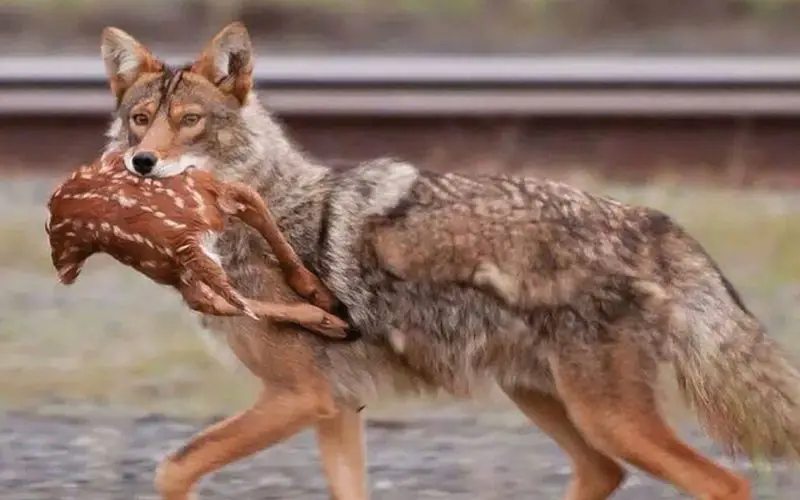Why hunt coyotes? People will justify any action if they feel it benefits them. People hunt coyotes to control their populations.
Money is an enticing reason to cull these animals, and so is keeping your hunting skills current.
People also hunt coyotes for many other reasons. But not everyone believes that coyote killing is humane.
Read on to learn many of the intricate details about the controversial practice of coyote hunting.
5 Reasons Why Coyotes Should Be Hunted
While the subject is sensitive, understanding these reasons is crucial for an informed discussion on wildlife management and conservation strategies.
1. Population Control

Despite the annual killing of over 400,000 coyotes, the interest in hunting them remains unwavering.
People debate whether coyotes are helpful to the environment because they keep pests like rats and mice under control. Controlling small vermin is beneficial for humans and coyotes, but who controls the coyote population?
In the United States, people have been hunting coyotes for over a century. Hunters use various weapons and techniques to trap and kill their prey. Still, despite their efforts, the coyote population continues to expand.
Due to ongoing threats to their lives, coyote populations in the U.S. are now migrating to South America.
Hunters argue that killing coyotes helps to maintain their population levels throughout the United States. In the United States, various states even hold regular competitions to see who can kill the most coyotes.
Hunters argue that they are delivering a service to the region by killing these animals, but the truth is that people enjoy hunting coyotes for the fun and challenge.
2. Extra Income
Depending on which state you live in, coyote killing can be quite a lucrative business. Some states want help from hunters to kill coyotes in population control efforts and pay a reasonable sum for each one that hunters eliminate.
If you’re a hunter and want to earn an extra income, this seems like a good enough reason why hunting coyotes is advantageous.
At one stage, South Carolina was paying $75 for each coyote killed. If you can bag five or ten of these animals in a day, $750 will pay for your hunting expenses and more.
Similarly, Utah was paying $50 per coyote head at one stage, so hunters can combine fun and earnings by killing coyotes throughout various U.S. states.
State bounties chop and change over the years, with some states having offered hunter’s rewards of up to $1,000 at one stage. When this type of bounty is available, hunters can gain more incentives to hunt coyotes.
As mentioned in the previous section, many states also run competitions where hunters earn various prizes for killing coyotes. Cash prizes are in the region of $500 and more, or hunters can win trapping packages or rifles for bringing in the most of the largest coyotes.
Overall, hunting coyotes revolves around fun and money, but you also gain multiple other benefits from this sport.
3. Polishing Your Skills

Hunters also get to polish their hunting skills when tracking, stalking, or waiting for a coyote. The way you hunt coyotes varies depending on where you are pursuing them.
Hunting strategies differ between hunting coyotes in flat land, hilly regions, or heavily forested areas. Hunters will also take a different approach to hunting coyotes near farmlands.
Terrain and coyote behaviors vary depending on where they live, so hunters must use several strategies to bag their prey.
Calling strategies, decoys, binoculars, and weapon choices are just some of the considerations when polishing your coyote hunting skills in various regions.
Wherever you choose to hunt, it is wise to find out more about coyote behavior in the area. Calling strategies, for example, involve listening for coyote calls in the quiet of the night.
Once you hear coyote calls, you can determine whether they are nearby or far away, as well as how many coyotes are in their surroundings. Your choice of weapon also depends on where you hunt these animals.
A rifle with a shorter barrel is better for tracking in wooded areas, for example, as there is less room to move. Avoid having the gun barrel entangled in foliage just as you’re about to sight your weapon.
4. Hunting All-Year-Round
Hunters in the United States have the opportunity to hunt coyotes throughout the year, as these animals are not considered game but pests.
The only time you need special permits to kill coyotes is if you want to harvest their pelts or sell your kills.
Other than this, there are few limitations on when and how you can hunt coyotes, but always check state laws to ensure your hunt is legal.
Hunting coyotes all year is another reason why it is beneficial. Hunters can use this opportunity to hone their skills in the off-season for larger games, but they rarely take advantage of the time.
Whenever you hunt coyotes, the moral standpoint ensures a clean kill, so the animal doesn’t suffer. Hunting throughout the year ensures you stay on top of your game, so you are more likely to make a clean kill.
5. Populations of Deer and Fawns

Hunters believe that controlling coyote populations will help them control deer and fawn populations. Researchers have conducted numerous studies on coyotes to determine their influence on deer and fawn populations.
While some of these studies support the idea that killing coyotes ensures the maintenance of other wildlife populations, others do not. Even if coyote culls help increase deer numbers, this increase may only last a season or two, then even out.
Studies do not clearly indicate that coyotes are solely responsible for the decline in deer and fawn populations, as they primarily hunt for food, rather than eliminating large numbers of game.
However, these figures don’t deter hunters because they understand the purpose of their coyote hunts. Coyotes also target other small creatures, such as turkeys and wild hares, which are also fair game for hunters.
Similarly, farmers also suffer massive livestock and financial losses due to coyote kills, giving hunters another good reason to hunt coyotes.
Arguments Against Coyote Hunting
There are numerous arguments in favor of hunting coyotes. However, there are also arguments against coyote culling, a practice that also enjoys significant support.
Over the centuries, people have used a variety of techniques to kill coyotes, including
- Shooting
- Trapping
- Poisoning
- Hunting dogs
- Several other cruel methods
We have previously addressed most of the reasons for coyote hunting, with population control being the most popular. The studies for and against coyote population control, as previously mentioned, remain mixed.
Despite efforts to control the numbers of these animals, they continue to breed and expand their territory across Northern and Southern America. None of the techniques described above are effective in maintaining coyote numbers for a variety of reasons.
Killing territorial creatures such as coyotes simply means that others will fill their place in short periods of time. Poisoning and trapping are cruel, as are many other inhumane techniques, which hunters should avoid as a matter of principle.
Instead of wantonly killing coyotes for fun, money, number control, safety, or any other reason, opponents against their killing have several arguments to support the position that killing coyotes is ineffective and cruel.
1. Killing Programs are Not Effective

Hunters cannot target problem coyotes that kill pets, livestock, or wild game.
Because it is almost impossible to identify guilty coyotes, hunters randomly kill all coyotes in the region, which is ineffective.
Despite the argument that hunting controls coyote populations, this statement is false. Coyote populations are increasing, partly due to hunting.
This increase is nature’s way of restoring breeding capabilities among surviving coyotes, as pregnancy rates and litter sizes make up for losses.
2. Removal Programs Don’t Work
Removing coyotes is expensive and doesn’t work because wildlife are territorial. Transferring these animals to another region negates the move, as their instinct is to return to their territory.
Additionally, coyotes operate in pairs, and the removal of these pairs results in the replacement of ‘floaters’ by single individuals.
Floaters often become nuisance coyotes, invading residential properties and digging through garbage.
3. Hazing

Coyotes use hazing as a technique to maintain their fear of people. When coyotes fear humans, they are more likely to avoid built-up areas, ensuring the safety of people, their pets, and the coyotes.
Hazing restricts undesirable coyote behaviors and activities, as well as the instinct to be close to human populations.
Hazing is the only reasonable way to keep coyotes from invading human territories, as killing them is inhumane.
Obviously, hunters won’t agree with these viewpoints. Still, the fact remains that bounties, trapping, and other methods used to kill coyotes don’t work as their populations continue to grow along with their territories.
Wrap-Up
Hunters thrive on hunting games, and if they believe coyotes are killing farm animals or other wild game, coyotes become fair game.
Additionally, coyote hunting can be a lucrative sport. You earn extra cash while having a good time. Hunters also believe that killing coyotes helps reduce their numbers.
Scientific studies differ on whether this is true or not, depending on where you look and the study’s variables. Despite the establishment of controls to maintain coyote populations, their numbers continue to increase.
This growth raises questions about the research’s validity. Organizations like the Humane Society also dispel the myth that coyote culling controls populations. Beyond this fact, they maintain that some killing techniques are cruel.
What is your take on this?